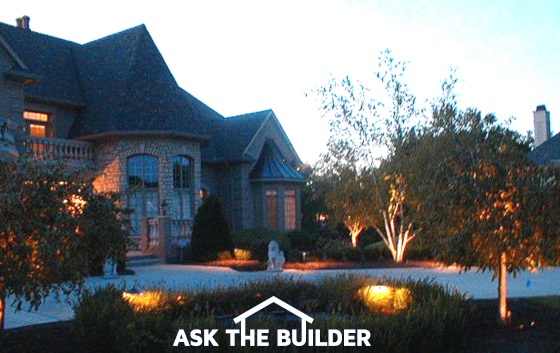Outdoor Lighting

This house is only several miles from mine. The outdoor lighting is just splendid at twilight.
DEAR TIM: Some of my neighbors' houses and gardens have some unique and interesting outdoor lighting. I asked them about it, and they said it is low-voltage outdoor lighting. Is this possible? Are there limitations to what you can do with exterior lighting? What should I be concerned about? Is it difficult to install? Lisa N., West Warwick, RI
DEAR LISA: High-powered low-voltage outdoor lighting is nothing new at all. The next time you are out driving at night and some idiot turns on his bright headlights in your face temporarily ruining your night vision, keep in mind those headlight bulbs are powered with just 12 volts of electricity.
The outdoor lighting industry has been making hundreds of exquisite low-voltage outdoor light fixtures in a multitude of finishes for all sorts of uses for over 40 years. Its popularity has exploded during the past 10 years.
There are many, many advantages to using low voltage lighting in outdoor applications. Lower voltage means smaller, more compact, light bulbs and light fixtures. This allows you to hide fixtures within landscaping so that they are not visible during daylight hours. Installation costs are much less than if you were to use traditional high-voltage fixtures. High-voltage wiring often requires conduit, and lots of labor to install all wiring and fixtures to meet or exceed the National Electrical Code.
Outdoor lights can be used to do all sorts of things. You can use them to create small, soft puddles of light to illuminate a garden path. Outdoor waterscapes can contain underwater lights that let you enjoy small ponds and waterfalls on those dark evenings when you are relaxing on your patio or deck. More powerful beams of light can shoot straight up or down to draw attention to specimen trees, bushes, or magnificent features of your home. Lights can be activated by timers, motion detectors, photo-electric cells, or traditional switches if you prefer.
The central core of a low-voltage outdoor lighting system is the power center. This is a high-performance transformer that steps down regular 120 volt household current to the low voltage needed to power your lights. These centers are often installed outdoors. Because low voltage means less energy, the power centers should be centrally located within the lighting arrangement. This keeps voltage loss to any one fixture at a minimum.
You need to be concerned about over-lighting. Many homeowners make mistakes by installing far too many exterior lights. To further complicate things, good intentioned homeowners often select the wrong lights. The first thing you need to do before you purchase any products is to decide exactly what you are trying to accomplish. Do you want security lighting, landscape lighting for trees only, architectural lights to highlight features on your home, or a combination of these? Each of these applications requires specific light fixtures equipped with specialized high performance lamp bulbs.
Also, keep in mind a growing interest in the dark skies movement. Some parts of the nation limit the amount of outdoor lighting, as it interferes with star gazing. Be sure you check with your local government code officials or in private subdivision regulations or covenants for dark skies policies.
Once you have a general idea of how many lights you think you might use, draw up a simple plan. Compare the number of lights you think you need to the actual number of lights you see at many of your neighbors' houses and gardens. Stop by and visit them and do an actual fixture count. You might be surprised to find out that you have too many lights in your plan.
Keep in mind that you can always add more lights at a later date. The power centers that feed the safe low voltage electricity to each light come in different sizes so you should plan ahead. If your initial lighting plan causes you to reach the capacity of a certain power center, it might be wise to upgrade to the next size. You will not regret this in the event you need to add several more lights as you begin to fall in love with what outdoor lighting can do for you.
Low-voltage outdoor lighting can be a challenge to install if you have no electrical experience. Voltage-drop calculations often need to be considered, cables and fixtures need to be sized, total light wattage needs to be calculated, power centers need to be sized, etc.
Some manufacturers have excellent step-by-step guidelines and booklets, but even after reading these, you may feel overwhelmed. Don't hesitate to obtain quotes from several outdoor-lighting experts in your area. Be sure to visit projects they have completed, and view them at night. Ask the homeowners if they would hire the company again to do additional work.
Companion Articles: Landscape Lighting, Low Voltage Landscape Lighting Resources, Low Voltage Landscape Lighting Problems, Low Voltage Outdoor Lighting Manufacturers
Column 285